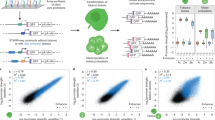Abstract
A typical eukaryotic promoter consists of a minimal promoter and other upstream cis elements1,2,3. The minimal promoter is essentially a TATA box region where RNA polymerase II, TATA-binding protein (TBP), and TBP-associated factors (TAFs) bind to initiate transcription4, but minimal promoters alone have no transcriptional activity1. The cis elements, to which tissue-specific or development-specific transcription factors bind, individually or in combination, determine the spatio-temporal expression pattern of a promoter at the transcriptional level1. The arrangement of upstream cis elements followed by a minimal promoter sets the polarity of the promoter. Promoters in plants that have been cloned and widely used for both basic research and biotechnological application are generally unidirectional, directing only one gene that has been fused at its 3′ end (downstream). It is often necessary to introduce multiple genes into plants for metabolic engineering and trait stacking5. It is also desirable to minimize or avoid repeated use of a single promoter that may cause transcriptional gene silencing6. Here we describe a strategy to make polar promoters bidirectional so that one promoter can direct the expression of two genes, one on each end of the promoter.
This is a preview of subscription content, access via your institution
Access options
Subscribe to this journal
Receive 12 print issues and online access
$209.00 per year
only $17.42 per issue
Buy this article
- Purchase on Springer Link
- Instant access to full article PDF
Prices may be subject to local taxes which are calculated during checkout



Similar content being viewed by others
References
Benfey, P.N. & Chua, N.-H. The cauliflower mosaic virus 35S promoter: combinatorial regulation of transcription in plants. Science 250, 959–966 (1990).
Lewin, B. Genes VI. (Oxford University Press, New York, NY; 1997).
Lam, E., Benfey, P.N., Gilmartin, P.M., Fang, R.-X. & Chua, N.-H. Site-specific mutations alter in vitro factor binding and change promoter expression pattern in transgenic plants. Proc. Natl. Acad. Sci. USA 86, 7890–7894 (1989).
Zawel, L. & Reinberg, D. Common themes in assembly and function of eukaryotic transcription complexes. Annu. Rev. Biochem. 64, 533–561 (1995).
Ye, X. et al. Engineering the provitamin A (β-carotene) biosynthetic pathway into (carotenoid-free) rice endosperm. Science 287, 303–305 (2000).
De Wilde, C. et al. Plants as bioreactors for protein production: avoiding the problem of transgene silencing. Plant Mol. Biol. 43, 347–359 (2000).
Hajdukiewicz, P., Svab, Z. & Maliga, P. The small, versatile pPZP family of Agrobacterium binary vectors for plant transformation. Plant Mol. Biol. 25, 989–994 (1994).
Jefferson, R.A. Assaying chimeric genes in plants: the GUS gene fusion system. Plant Mol. Biol. Rep. 5, 387–405 (1987).
Holtorf, S., Apel, K. & Bohlmann, H. Comparison of different constitutive and inducible promoters for the overexpression of transgenes in Arabidopsis thaliana. Plant Mol. Biol. 29, 637–646 (1995).
Gan, S. Molecular characterization and genetic manipulation of plant senescence (PhD Thesis). (University of Wisconsin, Madison, WI; 1995).
Gan, S. & Amasino, R.M. Inhibition of leaf senescence by autoregulated production of cytokinin. Science 270, 1986–1988 (1995).
Maiti, I.B. & Shepherd, R.J. Isolation and expression analysis of peanut chlorotic streak caulimovirus (PClSV) full-length transcript (FLt) promoter in transgenic plants. Biochem. Biophys. Res. Comm. 244, 440–444 (1998).
Biesgen, C. & Weiler, E.W. Structure and regulation of OPR1 and OPR2, two closely related genes encoding 12-oxophytodienoic acid-10,11-reductases from Arabidopsis thaliana. Planta 208, 155–165 (1999).
Bass, B.L. Double-stranded RNA as a template for gene silencing. Cell 101, 235–238 (2000).
Dasgupta, S., Collins, G.B. & Hunt, A.G. Co-ordinated expression of multiple enzymes in different subcellular compartments in plants. Plant J. 16, 107–116 (1998).
Sambrook, J., Fritsch, E.F. & Maniatis, T. Molecular cloning: a laboratory manual, Edn. 2. (Cold Spring Harbor Laboratory Press, Cold Spring Harbor, NY; 1989).
Gallie, D.R., Sleat, D.E., Watts, J.W., Turner, P.C. & Wilson, T.M.A. The 5′-leader sequence of tobacco mosaic virus RNA enhances the expression of foreign gene transcripts in vitro and in vivo. Nucleic Acids Res. 15, 3257–3273 (1987).
Davis, S.J. & Vierstra, R.D. Soluble, highly fluorescent variants of green fluorescent protein (GFP) for use in higher plants. Plant Mol. Biol. 36, 521–528 (1998).
An, G. Binary Ti vectors for plant transformation and promoter analysis. In Methods in enzymology: recombinant DNA, Vol. 153. (eds Wu, R. & Grossman, L.) 292–305 (Academic Press, San Diego, CA; 1987).
Bechtold, N., Ellis, J. & Pelletier, G. In planta Agrobacterium-mediated gene transfer by infiltration of adult Arabidopsis plants. C. R. Acad. Sci. Paris 316, 1194–1199 (1993).
Acknowledgements
We thank Dr. Richard Amasino (University of Wisconsin, Madison), Drs. George Wagner, Maelor Davies, Arthur Hunt, and Deane Falcone (University of Kentucky, Lexington) for critically reading this manuscript, Dr. Indu Maiti (University of Kentucky, Lexington) for the PClSV promoter, and Dr. Pal Maliga (State University of New Jersey, Piscataway) for pPZP family vectors. The work was supported by the US Department of Energy Basic Energy Sciences (Grant no. DE-FG02-99ER20330 to S.G.), the US Department of Agriculture National Research Initiative (Grant no. 2001-35304-09994 to S.G.), and the Tobacco and Health Research Institute at the University of Kentucky (grant to S.G.). Y.H. was supported in part by the University of Kentucky's Research Challenge Trust Fund (Plant Sciences).
Author information
Authors and Affiliations
Corresponding author
Rights and permissions
About this article
Cite this article
Xie, M., He, Y. & Gan, S. Bidirectionalization of polar promoters in plants. Nat Biotechnol 19, 677–679 (2001). https://doi.org/10.1038/90296
Received:
Accepted:
Issue Date:
DOI: https://doi.org/10.1038/90296
This article is cited by
-
Development of efficient synthetic promoters derived from pararetrovirus suitable for translational research
Planta (2021)
-
Engineered bidirectional promoters enable rapid multi-gene co-expression optimization
Nature Communications (2018)
-
Analysis of Promoters of Arabidopsis thaliana Divergent Gene Pair SERAT3;2 and IDH-III Shows SERAT3;2 Promoter is Nested Within the IDH-III Promoter
Molecular Biotechnology (2017)
-
Synthetic promoters in planta
Planta (2015)
-
A combinatorial bidirectional and bicistronic approach for coordinated multi-gene expression in corn
Plant Molecular Biology (2015)



